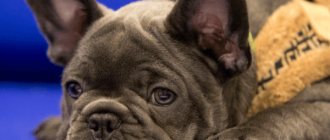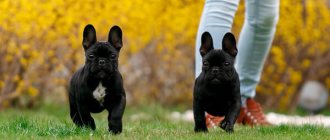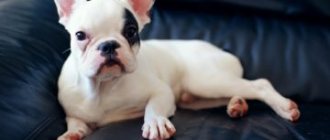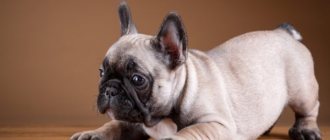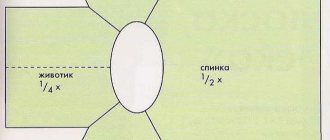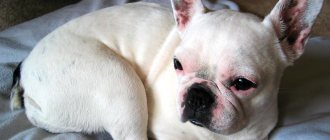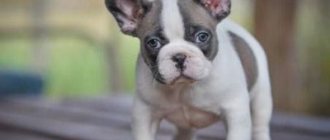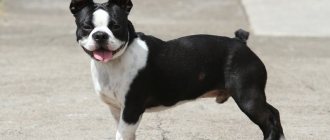Briefly about the characteristic features of the breed:
- Cute, trustworthy appearance - small stature, funny folds on the muzzle, ears like a bat, bulging eyes, clubbed limbs, the front of which are shorter than the back.
- The stable, balanced psyche of a healthy dog completely excludes the manifestation of anger, aggression and cowardice. The friendly French Bulldog loves children of any age.
- Tireless, playful, cheerful and loyal disposition.
- Calm and even melancholic character, loves to sleep, the dog can snore.
- Traits such as excessive pride or excessive laziness may be characteristic.
- Loves short and non-tiring games, especially in the fresh air.
- He becomes very attached to all family members and has a hard time withstanding separation.
- Swims poorly or does not swim at all due to its large head.
- Does not tolerate frost and heat well.
- The dog is prone to diseases of the eyes, spine, and obesity.
Characteristics: pros and cons of the breed
Male:
Bitch:
Price:
Life expectancy is about 12 – 13 years. |
Who is the breed suitable for? Who won't suit it? | Suitable:
Will not work:
|
How do you treat other pets and dogs while walking? | With proper upbringing and socialization, the breed is very sociable. He is calm with other family pets. Fearlessly gets acquainted with dogs of any gender that he meets on a walk. |
Is it possible to do without walking at all? | No, this is not advisable. Despite the fact that it is easy to train a dog to relieve itself in a tray or on an absorbent diaper, for harmonious development it needs short walks. |
What's best to feed? | There are two options: natural and dry food. It is not recommended to mix them. It is more convenient to feed dry, but it is important to choose only high-quality balanced premium and super premium food. It is undesirable to overfeed, as it is prone to obesity. |
How often should I bathe? | No more than twice every six months. It is important to wipe your pet’s skin after each walk with a well-absorbing towel, and monitor the hygiene of the ears, eyes, and skin folds. |
Is it normal for a French Bulldog to snore in his sleep and grunt during active play? | Yes, this is due to the short and flattened muzzle of the breed, and the brachycephalic shape of the skull. It is important to ensure that the dog does not become overtired during games and walks, or overheat in the sun or in a closed car. This can lead to fainting, respiratory failure and even death. |
Do I need to dock my tail or ears? | The ears are not cropped. Most puppies of the breed are born with short tails. But the birth of a long-tailed bulldog is also possible. According to the breed standard, this is not a disqualifying sign and is quite acceptable. In this case, the breeder decides whether to dock the tail or not. The procedure is usually carried out on the third day of the puppy's life. A decent breeder will definitely warn the buyer about this, since genetically the dog can pass on long tails to its descendants. |
Do I need to glue my ears or should they stand up on their own? | Usually the Frenchie's ears stand up at 3–4 months of life. In some individuals even earlier - at 2 months. But there are dogs whose heavy and fleshy ears do not stand up even at 6 months. In such cases, the ears can be glued using a bandage, cotton wool and adhesive tape. Eating a healthy diet and adding calcium to your diet can also help. |
How long should you walk your bulldog? | One hour a day will be enough. The optimal options are 2 times for half an hour or 3 times for 15-20 minutes. |
The advantages of the breed include:
- The possibility of being kept in a small apartment is due to the fact that there is no need for physical activity and long walks.
- No increased activity.
- Easy to raise and train, which can be trusted even to a child.
- Simple care for fur, ears, claws and other parts of the body.
- Easily tolerates a change of environment, traveling in a portable bag, or traveling in a car.
- Tolerance to excess affection and attention.
- Almost doesn't bark.
- Not aggressive.
Disadvantages and difficulties of content:
- Tendency to diagnoses such as heart and respiratory failure, colds, injuries and eye diseases, allergies, dermatitis, and spinal pathologies.
- Due to the brachycephalic shape of the skull, breathing problems, snoring, snoring, and heat intolerance are possible.
- Difficulty in reproduction - due to physiological characteristics, sometimes only artificial insemination and birth by cesarean section are possible.
- Needs clothing in winter to avoid hypothermia, and a hat in summer to prevent heatstroke.
- Prone to obesity, therefore requires vigilant monitoring of nutrition.
Contrary to popular opinion on the Internet, a French bulldog cannot perform the function of a protector or guard.
Characteristics of the French Bulldog
The French bulldog breed, beloved by many breeders, once descended from warlike mastiffs, which is why their character has passion and fearlessness.
But at the same time, the blood of good-natured pugs flows in their veins, so French bulldogs are gentle dogs that can get along in a family with children. They treat guests calmly and rarely come into conflict with other pets who live in the house. French bulldogs are smart and quickly learn commands. If necessary, they can stand up for the owner, and the size of the enemy will not be of particular importance to the bulldog. Like all other breeds, French bulldogs have their pros and cons, which will be discussed further.
Description of the breed: character and temperament
According to the characteristics of the breed, the French bulldog is a kind of psychologist. He subtly feels the relationships, fears and sympathies of the family in which he lives. He understands when his household is not interested in him and patiently dozes in his place. Feels when a person comes to visit, to whom everyone is happy and shares these emotions: he brings the guest his favorite toys, climbs onto his lap. If the guest is unexpected, he will bark and show his characteristic fearlessness.
The French Bulldog is an unobtrusive, lively, affectionate, sociable and balanced pet. There are no nervous individuals of this breed. He gets along well with the family in which he lives, loves children very much and is ready to forgive them any pranks, hugs, cuddles and other manifestations of affection. The dog is ready to follow the owner's heels, sleep at the feet or even in the owner's bed. He is very happy with praise and affection, and enthusiastically greets family members from work. It is very difficult for him to tolerate separation from his owner and being alone in an apartment for a long time. If you have to change the owner, he usually experiences enormous stress, although he tolerates the change of environment and living conditions very easily.
Dogs of this breed are very smart, which does not mean they are easy to train. It’s easy to teach them basic commands, but the French, due to its intelligence, is extremely cunning, so it is important not to indulge in the pet’s cute pranks and manifestations of laziness, otherwise it can turn into a desperate dirty trick, desperately manipulating the owner.
Photo of a French bulldog
Care and maintenance
Caring for a French Bulldog is easy.
Wool and bathing
Short hair is regularly combed with a regular stiff brush, first in the direction of hair growth, then against it. This removes dead hair. After a walk, you need to wipe the fur and skin folds with a damp towel or wet wipes, preferably baby wipes. The dog is rarely bathed - no more than 4 times annually. It is necessary to use only special high-quality shampoo for dogs, preferably with herbs. You cannot bathe until 9 months, so as not to disrupt skin-fat metabolism. Swimming should be mandatory after walking in muddy areas or after rain. Water should be used not hot (so as not to provoke the appearance of bald spots), but warm. After bathing procedures, wrap your pet in a warm, dry towel for a few minutes, so it will quickly cool down and dry without harm to health.
Care for skin folds
Folds, especially on the face, must be regularly inspected and wiped with a dry towel to avoid inflammation and infection. For lubrication, baby diaper rash cream or diaper rash cream is good. It is also useful for lubricating the space between the toes. The nose also needs care: treatment with a mixture of olive oil and pharmaceutical vitamin E in ampoules. Without this, crusts may appear on the lobe, and dryness will be tormented.
Claws, ears, eyes
Nails are trimmed as they grow only if they do not have time to wear down during walks. To make the procedure painless and quick, purchase a special nail clipper or electric scratching post. The ears are also treated to remove dirt with wet wipes or a cotton swab dipped in alcohol-free or baby lotion, sea buckthorn oil or Vaseline. The eyes can be cleared of regularly appearing mucus with gentle movements using a swab dipped in chamomile decoction.
Under no circumstances should you use tea or albucid to wipe your pet's eyes. They provoke increased inflammatory processes.
Teeth
An important task in caring for the breed is brushing its teeth. If it is not carried out at least once a week, by the age of 3–5 years your dog will begin to have problems with the jaws: the formation of tartar, tooth decay, inflammation of the gums, even periodontitis and purulent runny nose. Brushing a bulldog's teeth is very simple - the procedure is carried out by wrapping gauze around your finger and dipping it in baking soda or a special tooth powder for dogs. It will not take more than 5 - 7 minutes.
Caring for a dog in hot and cold weather
It is very important to protect your bulldog from heat and cold. Thin, short hair and the absence of undercoat do not protect the dog from bad weather, so it requires clothing for the season, preferably a waterproof overall with a hood or a jacket. You also need to take care of your headdress: a Panama hat in the hot weather or a hat in the cold season. If you suspect that your pet is overheated, pour cool water over it or simply wet its paws and belly, take it to the shade, and give it water. In winter, to warm up a frozen dog, you can run with him and play active games.
Feeding
Feeding your French Bulldog should be based on low-calorie but balanced food. Overfeeding is fraught with obesity for adults and rickets for puppies. To check if the bull has gained weight, feel his ribs, they should be palpable, his tummy should be tucked. A heavy, heavy gait is also a sign of overfeeding.
It is better not to give hard foods and bones, as this quickly wears down the teeth. Puppies are fed up to two months 6 times a day, up to three months - 5 times, up to 6 - 4 times, up to 12 - three times, and after that the dog is considered an adult and receives food twice a day.
Each dog is a mono-dietist, that is, it does not require variety in food. Moreover, it is harmful to the gastrointestinal tract. The main thing in food is not its taste, but its smell. Dogs have almost no taste.
Important rules:
- Remember that the Frenchman's stomach is not adapted to liquid food.
- If you feed your pet dry food, give him fresh vegetables or fruits daily, and replace dry food with natural products twice a week.
- The dog must have fresh and clean water available.
- Monitor reactions to new products. French bulldogs, especially young ones, are prone to food allergies. Most often it manifests itself in the appearance of bald patches on the skin around the eyes or behind the ears. Subsequently, the dog will comb these areas until they become sore.
- Food should be cut into small pieces, as the dog may greedily swallow a large piece and choke.
- You cannot feed your dog from the table. It will spoil him.
What should be included in a natural diet?
- Porridge (preferably buckwheat, rice, rolled oats, oatmeal).
- Vegetables are stewed with porridge or served raw.
- Meat (any kind except pork, preferably beef).
- Boneless sea fish fillet – raw.
- Boiled offal (hearts, kidneys, liver).
- Dairy products - cottage cheese, milk (up to two months), yogurt or kefir.
- Fruits and berries.
- Vegetable oil (preferably olive) – add a spoonful per serving several times a week.
- Greens, sprouted cereal seeds.
Prohibited products:
- pork;
- bones;
- River fish;
- broths;
- sausages and smoked meats;
- pickled products;
- salty;
- sweet;
- flour;
- pasta;
- legumes;
- semi-finished products;
- products from the “human” table.
English version of the origin of the French bulldog
The most common theory among kennel clubs is that the adorable “Frenchie” was descended from the Old English Bulldog, and inherited much from his illustrious ancestor. The similarity of these breeds becomes obvious if we consider the structure of their body, but English bulldogs had a powerful, medium-sized body on fairly high paws, and this breed was used in betting fights, shedding their blood in the arena for the amusement of the crowd. In 1802, the English Parliament decided to stop merciless dog fighting and issued a decree according to which dog fighting betting was prohibited, and English citizens were encouraged to engage in cynology in order to preserve and increase domestic breeds.
The law-loving Englishmen zealously began to implement the decree, and soon owning a bulldog began to be considered good manners in English society, that is, appearing in society accompanied by such a dog testified to the upbringing and patriotism of the owner.
A hundred years later, a huge number of clubs appeared in England, in which all lovers of charming bulldogs gathered, regardless of their social status. In 1903, a good third of the English people started talking about Londoner Reginald Edward Stubbs and his dogs, whose ears were like “tulip leaves,” and the official Stubbs’ description of his pets was almost identical to the characteristics of the modern French bulldog. Unfortunately, no images of Sir Stubbs' dogs have survived to this day.
It is possible that Alf Georg, who lived in the same area of London as Stubbs, brought dogs very similar to Stubbs’s pets to France in 1860, which the French immediately fell in love with. The number of dogs with ears in the form of tulip leaves on French soil was very small for a long time, they were incredibly expensive, and even some of these dogs were kept in enclosures at the Paris Zoo.
Common Diseases of the French Bulldog
Almost all diseases to which the breed is prone are associated with physiological characteristics - short muzzle, skull shape, bulging eyes, folded hair.
Eye diseases:
- conjunctivitis;
- keratitis;
- corneal erosion;
- entropion (turning of the eyelid).
Skin diseases:
- dermatitis (occurs as a result of poor care of skin folds);
- hypotrichosis (a congenital disease characterized by partial baldness);
- interdigital dermatitis (inflammation of the soft part of the paw with the claw).
Pulmonary diseases:
- snoring, snoring and grunting during excitement and increased activity;
- difficulty breathing in hot weather;
- brachycephalic syndrome (can only be treated with surgery).
Spinal diseases:
- genetic abnormalities: displacement of intervertebral discs, the appearance of hemivertebrae or, as they are also called, wedge-shaped vertebrae (provoke severe pain and can lead to complete atrophy of the limbs);
- vertebral displacement,
- discopathy;
- intervertebral hernia;
- osteochondrodysplasia;
- Achonproplasia.
Others
- Allergic reactions - most often to food, pollen, insect bites, dust.
- Problem childbirth - caused by the large size of the fetal head and the narrow pelvis of the bitch, usually requiring a cesarean section.
- Urolithiasis disease.
Description, character of the French bulldog breed
The first standard was published in 1898, then it was supplemented and updated more than once. The Fédération Cynologique Internationale made the latest changes in April 2015.
- Newborn puppies weigh 200–300 g. They reach their final size by 10–12 months, then gain muscle mass and become sexually mature at 1.5–2 years.
- Adult males weigh 9–14 kg and grow to 28–35 cm.
- Females look a little smaller, weigh 8–13 kg, and are 24–32 cm tall at the withers.
The standard allows deviation of height by 1 cm, body weight by 500 g
Breed standard
The French bulldog looks like a smaller copy of a fighting dog:
- The head is massive, square. The skull between the ears is flat, the forehead is convex. The eyebrows protrude and are separated by a furrow that does not reach the forehead. The skin gathers in folds.
- The stop is sharp, the muzzle is shortened, wide, folded.
- The nose is black, regardless of coat color, upturned, with open nostrils.
- The jowls are thick and free. The upper lip is slightly rounded, drooping, and meets the lower lip in the middle. The teeth and tongue are completely covered.
- The jaws are powerful, the lower one moves forward and rises. Cynologists consider a scissor or straight bite to be a serious drawback.
- The eyes are round, slightly protruding, low-set and widely spaced. The eyelids are edged with a black outline. The look is attentive, open, lively.
- The ears are erect, set high. The shell is wide at the base, narrows towards the tips, and slightly rounded at the top. The inner surface is completely visible from the front.
- The neck is strong, short, slightly widening towards the base.
- The body is strong and muscular. The length of the body is slightly longer than the height. The topline gradually rises from the withers to the loin.
- The back is wide, level, and does not sag.
- The chest is cylindrical, with rounded ribs, falling just below the elbows.
- The abdomen is smoothly tucked.
- The tail is short. Thick at the base, tapering towards the tip. The standard allows for kinks, irregularities, and length up to the hock joints. The tail is set low and drooped, and does not rise above the horizontal when running.
- The forelimbs are straight, the elbows are pressed to the body, the forearms are short and strong. The paws are rounded, collected, slightly turned outward. The fingers close tightly, the claws are strong and black.
- The hind legs are muscular, straight, slightly longer than the forelimbs.
- The skin on the body is dense, taut, without folds.
- The coat is smooth, short, close to the body, there is almost no undercoat.
Sometimes litters contain puppies with the dwarfism gene. An adult mini French bulldog weighs no more than 8 kg and is up to 28 cm tall. Such dogs are only bred for home use. Dog handlers reject them, do not register them and do not allow them for breeding.
French bulldog colors
The standard specifies 3 color options:
- Brindle is a combination of red and black hair. Sometimes the forehead, neck, and chest are covered with white marks.
Brindle color French Bulldog.
- Solid fawn - from coffee-milky to bright red. The muzzle and eyes are sometimes decorated with a black mask. White spots are allowed on the head, chest, and belly.
Fawn French Bulldog puppies.
- Spotted - brindle or fawn spots appear on a light background. The rare solid white color falls into this group if the dog has a black nose and edging around the eyes.
French bulldog spotted color.
Black, black-and-white, gray-blue, chocolate, and tricolor bulldogs are not allowed for exhibitions and breeding. The black color with red splashes stands out separately. It is not specified in the standard, but animals are allowed to participate in exhibitions. The blue color is recognized in America. Russian and European.
Blue French bulldog puppy.
The color of the coat does not affect the health, learning ability, or character of the animal. If you are not going to prepare the dog for shows or breed puppies for sale, then choose a color to suit your taste.
Personality of French Bulldogs
When looking at the “Frenchie,” you get the misleading impression of an easy-going, “sofa” dog that doesn’t need training. This attitude leads to unpleasant consequences. The pet becomes uncontrollable, and love of life and playfulness turn into self-will.
The French are very attached to their family, are ready to communicate 24 hours a day, and love to be the center of attention. They don't tolerate loneliness well, but they endure it in silence. They do not irritate neighbors by barking and howling. They are sensitive to mood changes and do not impose themselves if the owner is busy. They try to make their family laugh with their actions when they are out of sorts. On the street they fiercely defend if they feel threatened.
Young bulldogs up to 5–6 years old are able to play at any time. With age they become a little calmer and more restrained. For harmonious development, the French bulldog needs new experiences, walks where he can splash out his energy. Constant confinement changes behavior for the worse, even if the dog is litter box trained. Out of boredom, he gnaws on his master's things, makes a mess in the room, and goes to the toilet in the wrong places.
Attitude towards children and animals
The French Bulldog loves children's company and does not offend or bite children. The first month after the baby is born, the dog may become sad and require increased attention. But jealousy quickly gives way to affection for the new family member. Children under 6 years old are not left unattended with the dog. The animal may miscalculate its strength, inadvertently push, or accidentally scratch.
It is better to tell younger schoolchildren right away how to communicate with a pet. Teach not to pull the tail, paws and ears, and not touch the dog while eating. Regular pet care disciplines middle and high school students.
The French get along well with cats and dogs. People feel less bored in the company of another animal. However, on the street, an untrained dog can provoke a fight with a strong opponent because he is not aware of his small size.
Training and learning ability
The French Bulldog is smart but stubborn. A 2 month old puppy remembers simple commands “Come to me!”, “Place”. By six months they have mastered new ones - “You can’t”, “Sit”, “Lie down”. The pet is immediately weaned from biting, barking and growling at family members. Otherwise, the dog soon becomes the leader of the family.
In the depths of the subconscious of the good-natured French, the memory of their fighting ancestors is kept. The jaw strength of an adult dog is comparable to the bite of a large dog.
Sometimes obedient, trained puppies by the age of 8–10 months stop following commands, become stubborn, and become willful. The situation can be corrected if you quickly respond to any actions, good or bad. For correct behavior and following commands, praise and reward with tasty bites.
The French are not inclined to obey on demand. The level of obedience depends on the degree of trust, love and respect for the owner. The surest line of behavior with a pet is to establish equal, partnership relations, and not rush to extremes. It is equally bad to indulge too much or to be too strict. Patience, persistence, and repeated repetitions will lead to the desired result. The dog will become an intelligent, loyal, sensitive friend and companion.
Health
French bulldogs live 10 - 12 years, some long-livers - up to 14 - 15. Typical diseases they have are associated with physiology and genetics:
- Dermatitis. Delicate skin quickly becomes inflamed if not properly cared for. Most often, irritation is noticed in the folds of the muzzle, between the toes, under the tail, and on the pads of the paws.
- Allergy. The French Bulldog is one of the top five hypersensitive dog breeds. Irritants include food components, detergents, medications, parasites, pollen, even particles of the host’s skin. When rashes or baldness appear, you will have to conduct a whole investigation to find the allergen.
- Eye injuries and inflammation. In dogs with bulging eyes, pathogenic bacteria easily enter the mucous membranes and conjunctivitis develops. The first signs are severe lacrimation, purulent discharge, redness of the sclera. Protruding eyes are more susceptible to injury. Sometimes French people lose their third eyelid.
- Breathing problems. A healthy dog breathes silently, sometimes snores in his sleep, sniffles when excited, but sometimes the free access of air is blocked. This happens due to narrowing of the nostrils or blockage of the larynx with tissue from an overly long soft palate. Hoarse, heavy, noisy breathing, shortness of breath is a reason to take the dog to the veterinarian. Violations are corrected surgically.
- Otitis. The Frenchies' ears are open to dust and insects and often become inflamed. The first signs of otitis media are itching and purulent discharge from the ear canal.
- Spine problems. The French Bulldog is prone to developing defective vertebrae with an irregular wedge shape. Often the violation does not manifest itself at all. The owner doesn't even know about it. Sometimes the defective vertebra is displaced, putting pressure on the nerve endings and causing pain. The dog refuses to stand on its hind legs, climb the stairs, and is trembling. When there is severe pain, he squeals.
The French do not tolerate heat well. In summer, the pet is not tied up in the sun, not left in the car, or taken to the beach. In hot weather they walk in the shade. At home, they wet the belly, paws, and neck with cool water. In winter, short hair does not provide warmth, so the dog is warmed up before going outside.
When breeding French bulldogs, you will need the help of a veterinarian. In 90% of cases, the large head of the fetus does not pass through the birth canal; females undergo a cesarean section.
French bulldog puppy price
Experienced breeders determine the puppy’s prospects at 2–3 months. The price depends on external signs and physical condition:
- A healthy puppy with a non-standard color and exterior flaws costs in nurseries from 20 thousand rubles.
- A dog without external deviations from the standard costs 35–45 thousand.
- The price of puppies with impeccable parameters starts from 80 thousand rubles. The road to European and international exhibitions is open for such dogs.
Blue and black French bulldog puppies.
Breeders give away animals with physiological abnormalities and health problems free of charge. French bulldogs sell from 5 thousand. But there is a risk of adopting a dog with an unstable psyche, genetic diseases, and then treating it for the rest of its life.
On topic: Name generator if you haven’t yet chosen a name for the puppy.
Education and training
Raising a Frenchie does not require special training. He is smart and friendly enough to easily learn basic commands and domestic discipline. The companion does not require additional training.
It is very important for the charming but proud Frenchman to become a leader, a leader. This status must be earned and it does not mean that you need to shout at the animal, beat or humiliate it, or ban everything. A leader is someone who can be trusted, who will protect and not offend, but who will fairly punish for wrongdoing.
Some French Bulldog puppies have very clear leadership tendencies in their temperament, so you need to teach the dog from a young age that you can take his food bowl, sit on his bedding, and take his toys. A calm attitude towards such borrowing is considered a normal reaction.
Under no circumstances should a puppy or adult dog be allowed to bite, even in play. You should immediately stop such actions by placing the dog in a position of submission: lay it on its back and clasp its muzzle with your hand, holding it there until the pet stops struggling. The same should be done for any manifestation of aggression or even for preventive purposes during games. It is important to let the dog understand that obeying is not painful, not scary, not unpleasant. As a similar exercise for submission, you can use lifting by the fold of skin at the withers. It is also effective in cases of disobedience or aggression.
The Frenchman is distinguished by a powerful, well-developed jaw. If you leave your dog alone for a long time, you risk getting chewed upholstery on the sofa or damaged shoes. There is no point in scolding your dog for what he did. Leave him plenty of toys, special bones made from beef veins, don’t leave him for a long time.
The French Bulldog was once a fighting dog, so it is incredibly brave and fearless towards dogs of any size and temperament. Representatives of other breeds may perceive his characteristic wheezing as a challenge. Do not provoke the dog into fights, do not pit it against other individuals. Once he has felt the taste of battle and excitement, and even more so of victory, your Frenchie will begin to specifically challenge other dogs to fights. This is a difficult habit to break.
Temperament and character
The character of an adult French Bulldog is quite moderate, calm, and balanced . This breed has pros and cons.
As puppies, these little balls are lively and playful. They are so lively and playful that if you don't watch them closely, these hooligans will turn the house upside down. But with age, the “French” calm down and become more passive. They need active games, but outbursts of playfulness are rare.
A huge plus of the character of this breed is kindness, hospitality, friendliness, and love for children. If guests are on the doorstep, then this dog will not bark at them, but on the contrary, he will kindly introduce himself. The French love attention from both guests and hosts. As for other pets in the house, conflicts rarely occur.
The disadvantages of these dogs are pride. Some individuals are even vindictive, and if you offend them, they can remember this offense for the rest of their lives.
The next disadvantage is excessive laziness, which arises thanks to the owner. Of course, calmness and moderation are inherent in the breed, but at least sometimes you need to play with the dog.
The French Bulldog is good for those who are constantly busy with business and worries, and cannot devote much time to the dog. It is not for lovers of an active lifestyle : it is difficult to imagine a French bulldog on a hike or running after its owner on a bicycle.
Choosing a puppy
It is, of course, best to purchase a puppy from a trusted breeder or a kennel with a good reputation. If you have little understanding of the characteristics of the breed, then invite an independent expert with you. It is important to adhere to the basic rules:
- When buying a puppy, study the photo on the nursery’s website, ask to show the puppy’s parents, at least the bitch, talk to the owner of the nursery, carefully and leisurely study the documents: pedigree, veterinary passport. If the dog has a brand, compare its number with the one indicated on the documents.
- Make sure you have the necessary vaccinations and deworming.
- It is important that the room where the puppies are kept is clean, free of unpleasant odors and dirt.
- If the puppy suddenly didn’t turn up, was sold, got sick, etc., and they started offering you another one, then you shouldn’t cooperate with such an unreliable breeder. He who deceives once will deceive many more times.
- Examine the puppy itself. The puppy must meet the breed standard, be playful, active, cheerful, curious, not cowardly, clean, without unpleasant odors and discharge from the eyes or ears.
Remember that you are purchasing a pet for at least 10 years, and the time or money saved, insufficient research on the issue and a careless approach to choosing a seller can result in a lot of sores, genetic abnormalities or even the quick death of a dog that you and your family will manage to love.
Breed standard
| Usage | Decorative companion dog. |
| Origin | France |
| Appearance | A powerful, stocky, smooth-haired dog of strong build, small in size. |
| Temperament | Friendly, calm demeanor. Temperament is characterized by a stable, balanced mental state. Sociable and playful character. |
| Head |
|
| Frame |
|
| Limbs | Strong, developed, with clearly defined muscles, the hind legs are slightly longer than the front ones. The paw pads are hard and black. |
| Gait | The movements are light, leisurely and confident. The limbs are placed parallel to each other. |
| Wool | Short and smooth, fine in structure. |
| Color |
|
| Height |
|
| Weight |
|
| Note | Males must have a pair of clearly developed testes, completely descended into the scrotum. |
| Flaws | Any non-compliance with standard features. |
| Disqualifying faults |
|
French Bulldog Exterior Traits
The external characteristics of the French Bulldog are as follows: the dog’s physique is strong and compact. The weight of females reaches 8 - 13.5 kg, males - 9 - 14.5 kg. When looking at the animal, one immediately notices erect rounded ears, attentive wide-set eyes with black eyelids, a short upturned muzzle with a black nose. The neck of French bulldogs is short and quite muscular, the body is short and wide. The limbs of bulldogs are short in length, with well-developed muscles. The tail is thin and hanging (usually docked). The coat of these dogs is short, hard and thick. Acceptable coat colors include: fawn, red, brindle, white, spotted. In addition to the approved colors, bulldogs with blue, black, cream, brown, and tan coats are also in demand.
